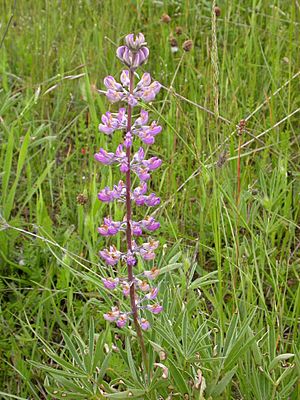Sulphur lupine facts for kids
Quick facts for kids Sulphur lupine |
|
|---|---|
 |
|
| Lupinus sulphureus ssp. kincaidii | |
| Conservation status | |
| Scientific classification | |
| Genus: |
Lupinus
|
| Species: |
sulphureus
|
The Sulphur Lupine (scientific name: Lupinus sulphureus) is a type of lupine plant. It's part of the legume family, also known as Fabaceae, which includes peas and beans. This plant gets its name from its yellow flowers, which can look like sulfur.
Contents
About the Sulphur Lupine
The Sulphur Lupine is a perennial plant, meaning it lives for more than two years. It's also a herbaceous plant, which means it has soft stems instead of woody ones like trees. These plants usually grow to be about 40 to 80 centimeters (about 1.3 to 2.6 feet) tall.
Its leaves are shaped like the palm of a hand with several "fingers." Each leaf has 7 to 13 smaller leaflets, and each leaflet is about 2 to 5 centimeters (about 0.8 to 2 inches) long. The flowers grow in groups called whorls on a tall spike. This spike can be 12 to 20 centimeters (about 4.7 to 7.9 inches) long.
Where Sulphur Lupine Grows
This plant is native to western North America. You can find it growing from southern British Columbia in Canada, south through Washington, and down to Oregon in the United States. It likes to grow in open, sunny areas.
Different Kinds of Sulphur Lupine
There are three main types, or subspecies, of Sulphur Lupine:
- Lupinus sulphureus subsp. kincaidii (Kincaid's Lupine): This type is found in the Willamette Valley of western Oregon and parts of southwestern Washington. Its flowers are usually purple. Kincaid's Lupine is considered a threatened species, which means it's at risk of disappearing.
- Lupinus sulphureus subsp. subsaccatus: This type grows from southern British Columbia down to Oregon. It also has purple flowers.
- Lupinus sulphureus subsp. sulphureus: This type is found in eastern Washington and eastern Oregon. Its flowers are typically yellow.
A Special Friend: Fender's Blue Butterfly
The Sulphur Lupine plays a very important role for a special insect called the Fender's blue butterfly. This butterfly is an endangered species, meaning it's in danger of becoming extinct.
Fender's blue butterflies are "host-specific" on Kincaid's Lupine. This means that the butterfly's larvae (which are like caterpillars) can only eat the leaves of Kincaid's Lupine. In the fall, the larvae eat the leaves and then spend the winter hidden among the plant's roots. When spring arrives, they continue to eat the leaves before they change into a pupa (a stage similar to a cocoon) and later become adult butterflies. This close relationship shows how important it is to protect plants like the Sulphur Lupine to help save endangered animals.


